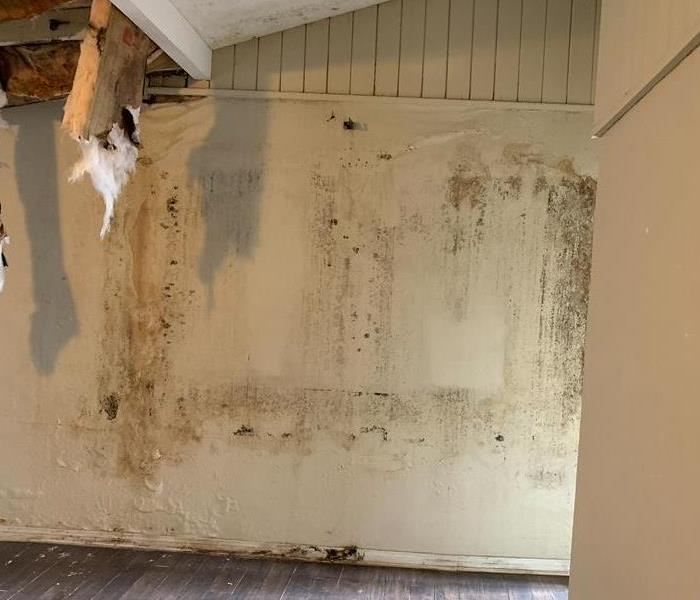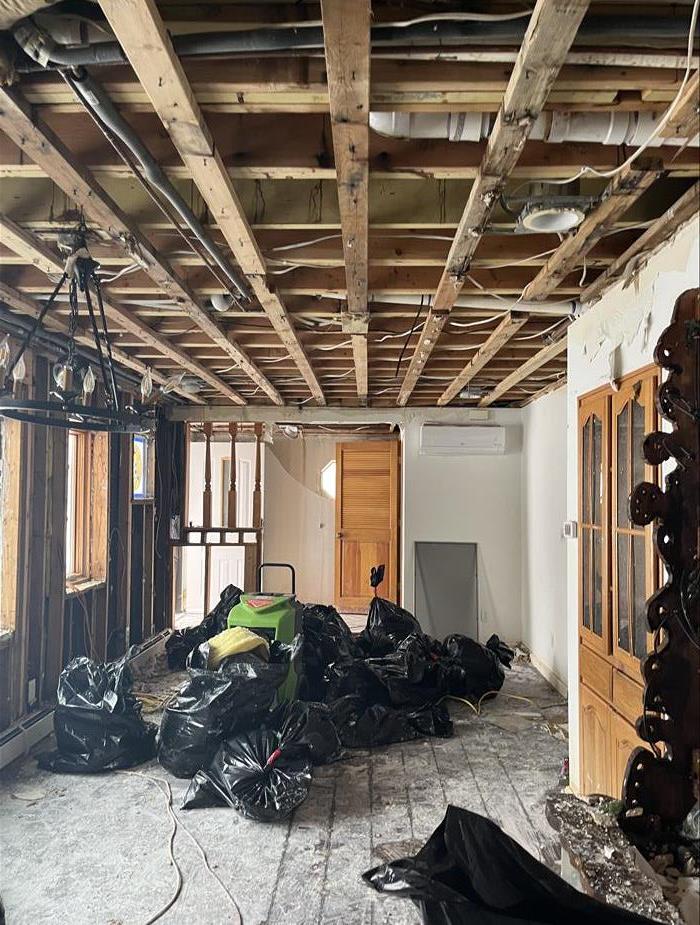Recent Mold Remediation Posts
Kitchen Mold: Prevention Tips and Effective Elimination Strategie
9/30/2024 (Permalink)
Your kitchen is one of the most frequently used spaces in your home, and it’s also a prime target for mold growth. If left unchecked, mold can spread quickly, damaging surfaces and creating an unpleasant environment.
The good news is that with proper prevention and elimination techniques, you can keep your kitchen mold-free. Let’s explore how you can prevent mold from taking over your kitchen and the steps to eliminate it if it’s already present.
Why Mold Grows in Kitchens
Mold needs three things to grow: moisture, warmth, and a food source. Kitchens often provide all three:
- Moisture: Steam from cooking, water from dishwashing, and spills or leaks create a damp environment.
- Warmth: Kitchens are often warm due to cooking and the use of appliances like stoves and dishwashers.
- Food Sources: Organic material like food scraps, grease, and dirt are ideal for mold growth.
Understanding these factors can help you take proactive steps to prevent mold from settling in.
How to Prevent Mold in Your Kitchen
Control Moisture
Since moisture is the key ingredient for mold growth, managing it is your first line of defense. Here’s how you can do that:
- Fix leaks immediately: Whether it’s a leaky faucet, a dripping pipe under the sink, or water seeping from the dishwasher, address any leaks as soon as they appear.
- Use a dehumidifier: If your kitchen tends to be humid, consider using a dehumidifier to reduce moisture in the air.
- Wipe up spills quickly: Don’t let water or other liquids sit on countertops or floors for long periods. Clean up spills immediately to prevent moisture buildup.
- Run your exhaust fan: Every time you cook or run hot water, turn on the kitchen exhaust fan to reduce humidity levels.
Clean Regularly
A clean kitchen is less likely to harbor mold. Here are a few cleaning tips to keep mold at bay:
- Wipe down surfaces: Regularly clean countertops, sinks, and backsplashes with warm, soapy water or a kitchen-safe cleaning solution to remove grease and food particles.
- Clean appliances: Mold can grow inside refrigerators, dishwashers, and microwaves. Clean these appliances regularly, especially seals and rubber gaskets where moisture can get trapped.
- Empty the trash: Don’t let food waste or damp items sit in your trash can for too long. Empty the trash regularly and clean the bin to avoid mold growth.
Ensure Proper Ventilation
Good airflow helps prevent moisture buildup. Here’s how to improve ventilation in your kitchen:
- Open windows: If your kitchen has windows, open them occasionally to let fresh air circulate and reduce humidity.
- Use ceiling fans: If you have ceiling fans, use them while cooking or cleaning to keep air moving.
- Keep cabinets open: Leave cabinet doors open occasionally to allow air circulation, especially under the sink, where mold is likely to grow.
Store Food Properly
Mold can grow on old or improperly stored food. Take these steps to prevent it:
- Store food in sealed containers: Keep leftovers, fruits, and vegetables in airtight containers to prevent mold spores from settling on them.
- Check for spoiled food: Regularly check your fridge and pantry for expired or spoiled food and dispose of it immediately.
How to Eliminate Mold in Your Kitchen
Identify the Source
Before cleaning, locate the source of the moisture that caused the mold. This could be a leaky pipe, poor ventilation, or even condensation from appliances. Fix the issue to prevent the mold from returning.
Use Mold-Removing Products
You don’t need harsh chemicals to remove mold from your kitchen. Many kitchen-safe products can do the job effectively:
- White vinegar: Spray undiluted white vinegar directly onto the moldy area and let it sit for an hour. Wipe it away with a damp cloth.
- Baking soda: Mix a teaspoon of baking soda with water to create a paste. Scrub the moldy area with the paste and then rinse with water.
- Dish soap and water: For light mold growth, warm soapy water can be enough to clean it off. Use a sponge or brush to scrub the area.
Always use gloves and proper cleaning materials when dealing with mold, and avoid using bleach on porous surfaces, as it can damage them without fully removing the mold.
Call SERVPRO® for Professional Help
If the mold is extensive or in hard-to-reach places, consider calling SERVPRO for professional mold remediation. SERVPRO’s team has the expertise and tools to remove mold safely and thoroughly, ensuring your kitchen is completely mold-free and protected against future outbreaks.
For more extensive mold issues, SERVPRO of Northern Colorado Springs/Tri-Lakes is here to help with professional mold remediation services, ensuring that your kitchen remains a safe and pleasant environment.
Bathroom Mold: Causes, Prevention, and Removal
7/17/2024 (Permalink)
Welcome to the SERVPRO® blog, where we tackle common household issues to keep your living spaces safe and comfortable. Today, we're diving into a topic that plagues many homeowners: bathroom mold. From its causes to effective prevention and removal techniques, let's explore how you can keep your bathroom mold-free.
Understanding the Causes
Mold thrives in environments with moisture, warmth, and organic matter, making bathrooms an ideal breeding ground. Common causes of bathroom mold include:
- Poor Ventilation: Inadequate ventilation traps moisture in the bathroom, creating a conducive environment for mold growth.
- Leaky Fixtures: Leaking pipes, faucets, or showerheads contribute to excess moisture, fostering mold growth behind walls and under flooring.
- High Humidity Levels: Humid environments, especially in poorly ventilated bathrooms, promote mold growth on surfaces like walls, ceilings, and grout lines.
- Lingering Moisture: Wet towels, bathmats, and shower curtains left in the bathroom provide additional moisture sources for mold.
Preventing Bathroom Mold
Prevention is key to avoiding the hassle and expense of dealing with bathroom mold. Here are some proactive measures you can take:
- Improve Ventilation: Install and use exhaust fans or open windows during and after showering to reduce humidity levels.
- Fix Leaks Promptly: Regularly inspect plumbing fixtures for leaks and repair them promptly to prevent moisture buildup.
- Use Mold-Resistant Products: Opt for mold-resistant paints, caulks, and grouts when remodeling or renovating your bathroom.
- Keep Surfaces Dry: Wipe down wet surfaces, such as shower walls, tubs, and sinks, after each use to prevent mold growth.
- Limit Moisture Sources: Store bath linens and personal care products in dry areas outside the bathroom to minimize moisture accumulation.
Effective Mold Removal Techniques
If you discover mold in your bathroom, it's essential to address it promptly to prevent further spread. Here are some tips for safe and effective mold removal:
- Protect Yourself: Wear protective gear, including gloves, goggles, and a mask, to avoid exposure to mold spores.
- Clean with Mold-Killing Products: Use commercial mold-killing cleaners or a mixture of water and detergent to scrub moldy surfaces thoroughly.
- Dry Thoroughly: After cleaning, ensure that the area is completely dry to minimize excess moisture and discourage mold regrowth.
- Dispose of Porous Materials: Items heavily infested with mold, such as shower curtains or grout, may need to be replaced to eliminate the mold completely.
- Seek Professional Help: For extensive mold infestations or if you're unsure about handling the situation yourself, contact a professional mold remediation service like SERVPRO for thorough and safe mold removal.
By understanding the causes of bathroom mold, implementing preventive measures, and knowing how to effectively remove mold, you can maintain a clean and healthy bathroom environment for you and your family. Stay tuned to the SERVPRO blog for more tips on home maintenance and restoration.
How Do I Get Rid of Mold in My Basement? A SERVPRO® Guide
3/17/2024 (Permalink)
 Remember, a mold-free basement is a happy and healthy space for your home.
Remember, a mold-free basement is a happy and healthy space for your home.
Basements, while valuable extensions of our homes, can sometimes become breeding grounds for mold. Let's dive headfirst into straightforward steps to bid farewell to the unwelcome guest – mold in your basement. No fuss, no frills, just effective methods to restore your basement to its mold-free glory.
1. Identify the Culprit
Mold loves moisture, and your basement might unknowingly provide the perfect environment. Begin by identifying and addressing the source of moisture. Leaky pipes, poor ventilation, or water seepage can be common culprits. Fixing these issues is the first crucial step in preventing mold from making a comeback.
2. Ventilation is Key
Basements often suffer from inadequate ventilation, creating a stagnant environment ideal for mold growth. Improve air circulation by opening windows, using fans, or installing a dehumidifier. Proper ventilation not only lowers the chances of mold but also improves the overall air quality in your basement.
3. Declutter
Mold loves to hide in the shadows, especially amid clutter. Declutter your basement to eliminate hiding spots and make it easier to spot mold growth. Keep storage items elevated to allow air circulation and reduce the chances of mold finding a cozy home.
4. Seal the Cracks
Inspect your basement for any cracks or gaps that might be letting moisture in. Seal these openings with caulk or other suitable materials. This not only prevents water leaks but also blocks potential entry points for mold spores.
5. Remove and Replace Porous Materials
Porous materials like cardboard, paper, or certain types of insulation are mold's favorite hideouts. If these materials are moldy, it's often best to remove them. Remove and replace them with mold-resistant alternatives to create an environment less conducive to mold growth.
6. Routine Checkups: Keep Mold at Bay
Regular inspections and maintenance are your secret weapons against mold recurrence. Schedule routine checks for any signs of water damage, leaks, or early mold growth. Nipping potential issues in the bud prevents mold from spreading and ensures a consistently mold-free basement.
In conclusion, getting rid of mold in your basement doesn't require magic – just practical measures and a proactive approach. Identify and eliminate moisture sources, improve ventilation, declutter, scrub away visible mold, seal cracks, replace porous materials, and schedule routine checkups. With these steps, you can transform your basement into a mold-free space, reclaiming it for storage, living space, or whatever purpose you envision. Remember, a mold-free basement is a happy and healthy space for your home.

 24/7 Emergency Service
24/7 Emergency Service

